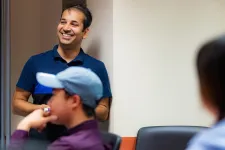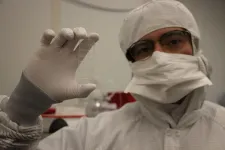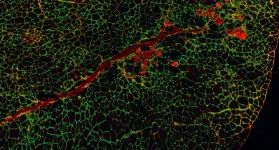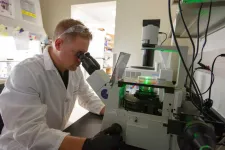Clinical trial completion rates decline during COVID-19 pandemic
2021-04-07
(Press-News.org) HERSHEY, Pa.-- Social distancing and lockdowns may have reduced the spread of COVID-19, but researchers from Penn State College of Medicine also report those actions may have affected clinical researchers' ability to finish trials. Study completion rates dropped worldwide between 13% and 23%, depending on the type of research sponsor and geographic location, between April and October 2020.
Researchers previously reported that more than 80% of clinical trials suspended between March 1 and April 26, 2020, noted the pandemic as their chief reason for halting activity. Patient enrollment in studies was lower in April 2020, compared to April 2019. Arthur Berg, associate professor of public health sciences, and Nour Hawila, a biostatistics doctoral candidate, investigated how these trends may have affected the completion of clinical trials.
The researchers examined more than 117,000 trials in the United States, Europe, Asia and other regions to study whether the pandemic affected clinical research. Their goal was to assess how the pandemic's mitigation efforts and financial setbacks may have contributed to decreased clinical trial enrollment and completion.
"The pandemic has made it more difficult for researchers to recruit and follow up on patients in clinical trials," said Hawila, a research assistant from the Department of Public Health Sciences. "This analysis revealed that the impact was substantial -- particularly for trials funded by government, academic or medical entities."
Hawila and Berg analyzed data from ClinicalTrials.gov, a website that contains information on the status of thousands of clinical trials in the U.S. Pre-COVID-19 enrollment and completion data was pulled from March 2017 to February 2020. The post-COVID-19 period was defined as April through October 2020.
According to researchers, the pandemic reduced the number of new interventional clinical trial submissions to ClinicalTrials.gov by about 10%. Completed trials were down 13% to 23%, depending on the sector and location of the trial source. Clinical trials sponsored by pharmaceutical, biotechnology and therapeutic companies were more likely to complete enrollment.
However, some regions fared better than others during the pandemic. Egypt experienced an increase in both submitted (69%) and completed (73%) clinical trials. Berg explained that the rise is likely in response to the country's recent parliamentary bill governing medical research.
Berg and Hawila also noted that the pandemic caused a shift in research priorities -- 472 (11%) of trials submitted during the post-COVID period were pandemic-related. The results were published in the journal Clinical and Translational Science.
"Clinical research response to the pandemic has been robust," said Berg, a Penn State Cancer Institute researcher and biostatistics doctoral program director. "But the impact of the pandemic on other types of clinical trials will be felt for decades to come. However, as demonstrated in Egypt, timely governmental action may be able to make a difference in reversing the pandemic's impact on research."
INFORMATION:
This work was supported by the National Institutes of Health and the National Center for Advancing Translational Science through Penn State Clinical and Translational Science Institute (grant UL1 TR002014). The content is solely the responsibility of the authors and does not necessarily represent the official views of the NIH. The authors declare no conflicts of interest.
ELSE PRESS RELEASES FROM THIS DATE:
2021-04-07
WYOMISSING, Pa. -- Teaching people to become entrepreneurs requires more than just passing on entrepreneurial skills, according to a team of Penn State Berks-led researchers. Would-be entrepreneurs also need to understand -- and negotiate -- the barriers that they might face.
In a study, researchers built a multidimensional model to measure the effectiveness of entrepreneurship education. The model not only includes teaching entrepreneurial skills, but also addresses the students' intentions to start a business and their perceptions of the barriers they might encounter when starting a business.
"There are a lot of studies in the literature that focus on, for example, how entrepreneurship education ...
2021-04-07
HOUSTON -- (April 7, 2021) -- Rice University computer scientists have demonstrated artificial intelligence (AI) software that runs on commodity processors and trains deep neural networks 15 times faster than platforms based on graphics processors.
"The cost of training is the actual bottleneck in AI," said Anshumali Shrivastava, an assistant professor of computer science at Rice's Brown School of Engineering. "Companies are spending millions of dollars a week just to train and fine-tune their AI workloads."
Shrivastava and collaborators from Rice and Intel will present research that addresses that bottleneck April 8 at the machine learning systems conference MLSys.
Deep neural networks ...
2021-04-07
In an article published in the April 8 issue of Nature, the National Institutes of Health's Somatic Cell Gene Editing Consortium provided a detailed update on the progress of their nationwide effort to develop safer and more effective methods to edit the genomes of disease-relevant somatic cells and reduce the burden of disease caused by genetic changes.
Gene editing allows scientists to modify sections of an organism's DNA and is considered a promising treatment for a number of genetic diseases. There have been numerous advances in the laboratory over the last few decades, but there are still many challenges to overcome before gene editing can be widely used in the patient population. Launched in 2018, the Somatic Cell Gene Editing Consortium ...
2021-04-07
A natural brilliant blue coloring has been discovered by an international team of researchers including chemists at the University of California, Davis. The new cyan blue, obtained from red cabbage, could be an alternative to synthetic blue food colorings such as the widely used FD&C Blue No. 1. The work is published April 7 in Science Advances.
"Blue colors are really quite rare in nature - a lot of them are really reds and purples," said Pamela Denish, a graduate student working with Professor Justin Siegel at the UC Davis Department of Chemistry and Innovation Institute for Food and Health.
Having ...
2021-04-07
Scientists have developed a long-sought naturally derived cyan blue colorant sourced from red cabbage anthocyanin pigments that may offer an alternative to the industry standard blue dye, although more testing is needed to determine the compound's safety. The novel colorant, which was developed using an enzyme that converts a range of anthocyanins to one with the ideal wavelength, remains highly stable over time and may also produce better green colors than those derived from existing natural blue colorants. Several research programs around the world are dedicated to the hunt for a natural alternative to FD&C Blue No.1 - a challenging effort given that cyan blue is one of the rarest colors in nature. While previous research has shown that ...
2021-04-07
DURHAM, N.C. -- An interdisciplinary team of scientists at Duke University has developed a highly sensitive and rapid diagnostic test for Ebola virus (EBOV) infection. In monkeys infected with Ebola, this diagnostic, called the D4-assay, proved to be 1000 times more sensitive than the currently approved rapid diagnostic test and capable of detecting the virus a full day earlier than the gold standard polymerase chain reaction (PCR) test.
This work, which appears in Science Translational Medicine on April 7, was done by biomedical engineers, molecular ...
2021-04-07
Progression of Duchenne Muscle Dystrophy (DMD) can be delayed in mice by supplementing their diets with Urolithin A, according to new results reported today. The findings, published in Science Translational Medicine, raise hopes that new treatment options could one-day be developed for DMD, an uncurable genetic condition characterized by progressive muscle degeneration. About 1 in 3,500 boys are born with DMD, which usually develops in childhood and significantly reduces life expectancy.
The new research carried out at the laboratory of Professor Johan Auwerx, ...
2021-04-07
The lungs were for a long time considered to be sterile in health, while in diseases like chronic obstructive pulmonary disease (COPD) failure in immune mechanisms were thought to allow microorganisms to proliferate and persist. New sequencing techniques have shown that several microorganisms reside in the lungs of healthy individuals, as well. Few studies have examined the fungal community in COPD and compared it to healthy controls using such techniques. According to the study findings, the compositions of these environments seem to be unaffected by the use of inhaled steroids.
Lungs have a unique fungal environment
The Bergen COPD Microbiome study (short name "MicroCOPD") is the world's largest single-centre study on the fungal community in ...
2021-04-07
JUPITER, FL - People with Crohn's disease are typically treated with powerful anti-inflammatory medications that act throughout their body, not just in their digestive tract, creating the potential for unintended, and often serious, side effects. New research from the lab of Mark Sundrud, PhD, at Scripps Research, Florida suggests a more targeted treatment approach is possible.
Crohn's disease develops from chronic inflammation in the digestive tract, often the small intestine. More than half a million people in the United States live with the disease, which can be debilitating and require repetitive surgeries to remove irreversibly damaged intestinal tissue.
Writing in the journal Nature on April 7, Sundrud's team finds that certain immune cells ...
2021-04-07
Tracking carbon dioxide levels indoors is an inexpensive and powerful way to monitor the risk of people getting COVID-19, according to new research from the Cooperative Institute for Research in Environmental Sciences (CIRES) and the University of Colorado Boulder. In any given indoor environment, when excess CO2 levels double, the risk of transmission also roughly doubles, two scientists reported this week in Environmental Science & Technology Letters.
The chemists relied on a simple fact already put to use by other researchers more than a decade ago: Infectious people exhale ...
LAST 30 PRESS RELEASES:
[Press-News.org] Clinical trial completion rates decline during COVID-19 pandemic




